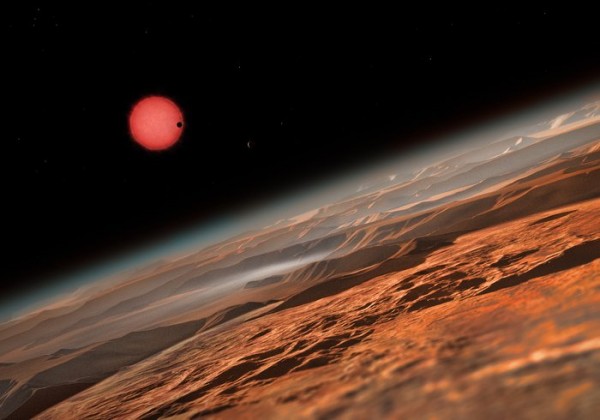By Ana Verayo, | May 03, 2016

This artist’s impression shows an imagined view from close to one of the three planets orbiting an ultracool dwarf star just 40 light-years from Earth that were discovered using the TRAPPIST telescope at ESO’s La Silla Observatory.
Humans colonizing Mars may soon come true in the 2030s courtesy of SpaceX and NASA, making science fiction a reality. This includes the reality of habitable alien planets like these three Earth like planets that are recently detected by astronomers that are orbiting a nearby star, suggesting that the worlds are conducive for water and life.
Like Us on Facebook
In this new study, the size of these exoplanets including their overall climates and temperatures are similar to Earth and Venus, which means that these alien worlds offer the best probability of life outside the solar system. Scientists also reveal that each of these three planets possess temperate regions that can sustain the existence of liquid water and life.
These three exoplanets are discovered orbiting a host star that can be described as an "ultracool" dwarf star, just 40 light years away from our planet. This can be estimated at 240 trillion miles away, or in astronomical terms, this is close enough to our solar system, since the Milky Way galaxy spans 100,000 light years.
According to co-author of the study, Emmanuël Jehin from the University of Liège in Belgium, this can be considered as a paradigm shift when it comes to planet populations and the discovery of new life in the universe.
He adds that, prior to this discovery, the existence of habitable worlds known as "red worlds" that are orbiting ultracool dwarf stars were only in theory. Now, this incredible finding does not only include one lonely planet around a faint, red star, but a complete star system of three worlds.
This discovery was thanks to a group of astronomers from NASA, MIT and the University California San Diego and the University of Liège. Using the Transiting Planets and Planetesimals Small Telescope (TRAPPIST) telescope in Chile, this red dwarf star is now dubbed as TRAPPIST-1, where this star is estimated to be the size of Jupiter, located in the Aquarius constellation. TRAPPIST-1 is also about one eighth of our sun and significantly cooler.
Astronomers have detected the new planets when they noticed the dimming of this star as the planets orbit around their sun, which blocked the light that is passing through from the direction of their location to our night skies.
Even if the TRAPPIST-1 system is relatively near Earth's neighborhood, the star is still too dim and too red to be observed from the night skies or even with a large amateur telescope. This new study is published in the journal Nature.
-
Use of Coronavirus Pandemic Drones Raises Privacy Concerns: Drones Spread Fear, Local Officials Say

-
Coronavirus Hampers The Delivery Of Lockheed Martin F-35 Stealth Fighters For 2020

-
Instagram Speeds Up Plans to Add Account Memorialization Feature Due to COVID-19 Deaths

-
NASA: Perseverance Plans to Bring 'Mars Rock' to Earth in 2031

-
600 Dead And 3,000 In The Hospital as Iranians Believed Drinking High-Concentrations of Alcohol Can Cure The Coronavirus

-
600 Dead And 3,000 In The Hospital as Iranians Believed Drinking High-Concentrations of Alcohol Can Cure The Coronavirus

-
COVID-19: Doctors, Nurses Use Virtual Reality to Learn New Skills in Treating Coronavirus Patients







